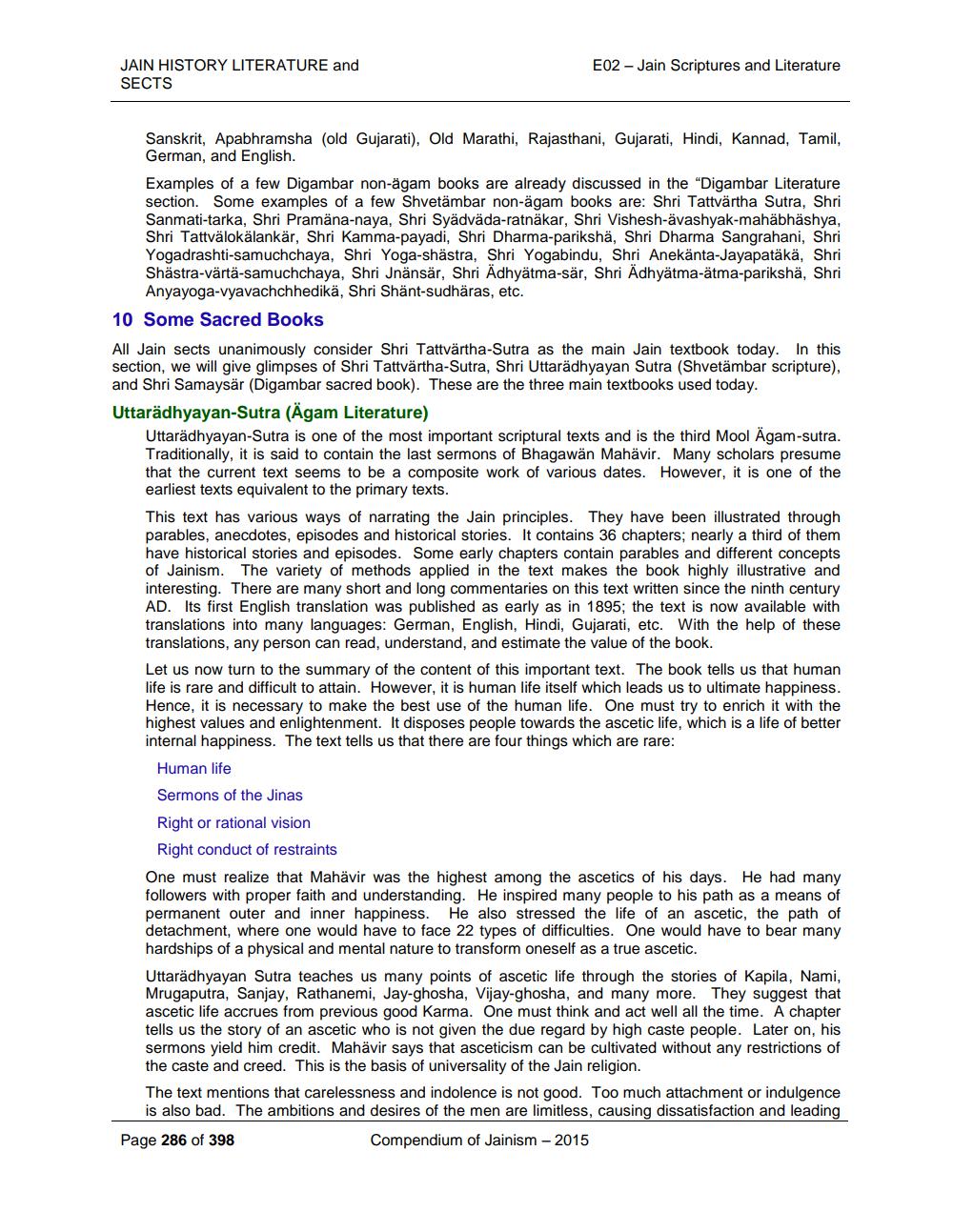________________
JAIN HISTORY LITERATURE and
SECTS
E02 Jain Scriptures and Literature
Sanskrit, Apabhramsha (old Gujarati), Old Marathi, Rajasthani, Gujarati, Hindi, Kannad, Tamil, German, and English.
Examples of a few Digambar non-ägam books are already discussed in the "Digambar Literature section. Some examples of a few Shvetämbar non-ägam books are: Shri Tattvärtha Sutra, Shri Sanmati-tarka, Shri Pramäna-naya, Shri Syädväda-ratnäkar, Shri Vishesh-ävashyak-mahäbhäshya, Shri Tattvälokälankär, Shri Kamma-payadi, Shri Dharma-parikshä, Shri Dharma Sangrahani, Shri Yogadrashti-samuchchaya, Shri Yoga-shästra, Shri Yogabindu, Shri Anekänta-Jayapatäkä, Shri Shästra-värtä-samuchchaya, Shri Jnänsär, Shri Ädhyätma-sär, Shri Ädhyätma-ätma-parikshä, Shri Anyayoga-vyavachchhedikä, Shri Shänt-sudhäras, etc.
10 Some Sacred Books
All Jain sects unanimously consider Shri Tattvärtha-Sutra as the main Jain textbook today. In this section, we will give glimpses of Shri Tattvärtha-Sutra, Shri Uttarädhyayan Sutra (Shvetämbar scripture), and Shri Samaysär (Digambar sacred book). These are the three main textbooks used today.
Uttarädhyayan-Sutra (Ägam Literature)
Uttarädhyayan-Sutra is one of the most important scriptural texts and is the third Mool Ägam-sutra. Traditionally, it is said to contain the last sermons of Bhagawän Mahävir. Many scholars presume that the current text seems to be a composite work of various dates. However, it is one of the earliest texts equivalent to the primary texts.
This text has various ways of narrating the Jain principles. They have been illustrated through parables, anecdotes, episodes and historical stories. It contains 36 chapters; nearly a third of them have historical stories and episodes. Some early chapters contain parables and different concepts of Jainism. The variety of methods applied in the text makes the book highly illustrative and interesting. There are many short and long commentaries on this text written since the ninth century AD. Its first English translation was published as early as in 1895; the text is now available with translations into many languages: German, English, Hindi, Gujarati, etc. With the help of these translations, any person can read, understand, and estimate the value of the book.
Let us now turn to the summary of the content of this important text. The book tells us that human life is rare and difficult to attain. However, it is human life itself which leads us to ultimate happiness. Hence, it is necessary to make the best use of the human life. One must try to enrich it with the highest values and enlightenment. It disposes people towards the ascetic life, which is a life of better internal happiness. The text tells us that there are four things which are rare:
Human life
Sermons of the Jinas
Right or rational vision
Right conduct of restraints
One must realize that Mahavir was the highest among the ascetics of his days. He had many followers with proper faith and understanding. He inspired many people to his path as a means of permanent outer and inner happiness. He also stressed the life of an ascetic, the path of detachment, where one would have to face 22 types of difficulties. One would have to bear many hardships of a physical and mental nature to transform oneself as a true ascetic.
Uttarädhyayan Sutra teaches us many points of ascetic life through the stories of Kapila, Nami, Mrugaputra, Sanjay, Rathanemi, Jay-ghosha, Vijay-ghosha, and many more. They suggest that ascetic life accrues from previous good Karma. One must think and act well all the time. A chapter tells us the story of an ascetic who is not given the due regard by high caste people. Later on, his sermons yield him credit. Mahävir says that asceticism can be cultivated without any restrictions of the caste and creed. This is the basis of universality of the Jain religion.
The text mentions that carelessness and indolence is not good. Too much attachment or indulgence is also bad. The ambitions and desires of the men are limitless, causing dissatisfaction and leading Compendium of Jainism - 2015
Page 286 of 398




